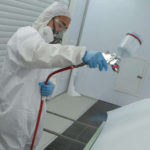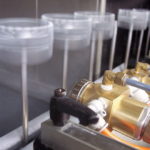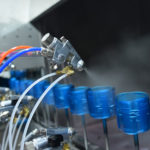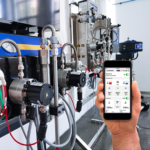Many customers are not sure about the conditions that need to be met before using electrostatic spray gun. Today, we will discuss about the conditions and tips of the electrostatic spray gun operation.
1. Painting room air flow speed
When spraying with an electrostatic spray gun, it is recommended the air flow speed and exhaust volume of spray booth be less than normal air based spraying. Firstly, electrostatic spraying paint fog and solvent evaporation is small, does not need too high exhaust air volume. On the other hand, if air flow is too big, it will directly affect paint absorption force in electric field and affect the electrostatic effect. The general electrostatic spray gun, recommended air flow speed is 0.5 ~ 0.7 m/s.
2. Grounding requirements for electrostatic spray gun
The electrostatic spray gun, the object to be coated, the person entering the spraying area, ground and equipment of the spraying area must be grounded. The resistance to ground is required to be less than 2MΩ, and the charge on object surface should be output in time to prevent charge accumulating and potential safety issues.
3. Resistance of coating
The electric contact properties of paint directly affect the electrostatic atomization and paint application rate, which plays a key role in paint saving. If the resistance value is too high, it is difficult to charge so the static effect is poor. If it is too small, it is easy to leak electricity, which is harmful to spray gun and unsafe to use. Electrostatic spray guns of various sizes have their specific resistance range.
4. Coating viscosity
The coating viscosity for electrostatic spraying is generally lower than regular air spraying, which is beneficial to improve the atomization effect, paint fog is easy to be deposited along the direction of power line.
5. Air pressure
Under the same pipeline paint system conditions, electrostatic spray gun requires less pressure than the normal air spray gun. Excessive air pressure affects the turbine generator normal operation and also electrostatic effect. The air pressure is generally set 4*104 to 5*104 Pa.
6. Paint pressure
Compared with ordinary air spray guns, electrostatic spray guns require a slightly lower paint pressure, paint output pressure is generally 0.15~0.18MPa. Flow rate of the coating is controlled at 350-450ml/min, spray gun distance 200-350mm, FAN width is 250-350mm.
7. Attentions:
Operation requirements: The distance between the spraye guns and object is slightly bigger than regular air spray gun. When two or more spray guns are operated at the same time, keep some distance with each other so paint flow should not interfere with each other and avoid electric contact.
Safety requirements for electrostatic gun: The most important part of electrostatic spraying is safety. The state has issued relevant safety standards, following safety measures and safety checks are required each time for using.
- Spray gun system safety: The spray gun system must be safely grounded, and the resistance of the gun body to ground is less than 1~2MΩ.
- Human safety: The operator and all personnel entering work area must wear conductive shoes. The operator is not allowed to wear insulated gloves. The body resistance to ground is less than 1~2MΩ.
- Workpiece state: The ground chain trolley or guide rail is reliably grounded, and the workpiece is in point or line contact. The resistance of the workpiece to ground is less than 2MΩ, otherwise the electrostatic effect is directly affected or even the paint fog is bounced to operator.
- Work area safety: All flammable liquids in the work area must be placed in a safely grounded container, and all electrical conductors should be grounded.
- Operation guarantee: All operators must be trained to use the electrostatic spray gun system safely and master the pressure relief technology.
Three elements of electrostatic spray gun painting
The so-called three elements of electrostatic spray gun spraying: the distance of painting, the trajectory of operation and overlapping of spraying. These three are important factors that directly affect painting quality. All are subjective factors so we must pay attention during operation.
1- the distance of spraying
The spraying distance refers to the distance from spray nozzle to object surface. The traditional air spraying distance is: big spray gun 20~30CM, small spray gun 15~25cm electrostatic spray gun spraying distance is generally 20~30cm. If spraying distance is too close, coating film is thick and easy to sag; if the spraying distance is too far, coating film is thin and coating loss rate is increased.
2- the operation of the trajectory
The trajectory of the gun operation needs to consider both the angle of spraying and speed of the gun. When spraying, keep the spray gun at right angles to object surface and run in parallel. The spray gun moving speed is generally adjusted within 30~60 cm/s, and it is required to be constant. If the spray gun is tilted and runs in a circular path or running speed is variable, uniform thickness coating film cannot be obtained, which may cause the film to produce smudges, orange peel and sag etc.
3- atomization and spray width
The overlap width of the spray pattern should be kept constant. If the lap width is variable, the film thickness is not uniform.




